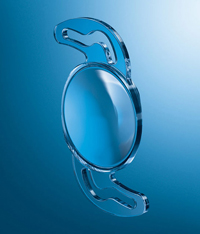Rayner reports FDA approval for the C-flex® injectable intraocular lens
5/3/2007Rayner Intraocular Lenses Ltd proudly announced today that it received PMA (pre-market approval) for the C-flex® injectable intraocular lens from the US Food and Drug Administration (FDA).
US Eye Surgeons now have a greater choice.
The FDA is renowned for being the strictest and most exacting regulatory authority and this approval for Rayner C-flex® is the first in more than twenty years for an intraocular lens made by a non-US IOL-manufacturer. This is also the first of the latest generation ofhydrophilic acrylic lenses approved by FDA. The C-flex® technology is already approved and widely used in Europe, Middle East, Asia, South America, South Africa and Australia.
At the company’s headquarters in Hove, East Sussex, Mark Mullaney, Rayner’s  Regulatory Affairs & Quality Assurance Director explained, “C-flex® injectable acrylic lenses have our well-established AVH Technology® plus the unique Enhanced Square Edge for reducing the risk of secondary cataract. The bio-compatible Rayacryl® materialhas an unmatched track record on low affinity for silicone oil, sustained clarity and an absence of glare and unwanted imagery. TheAnti-Vaulting Haptics provide excellent centration, no rotation and no vaulting and this largely contributes to accurate visual outcomes. But the system is more than just the lens. It is also a “first” in that the lens is uniquely packaged with an FDA-approved single-piece, single-use injector.”
Regulatory Affairs & Quality Assurance Director explained, “C-flex® injectable acrylic lenses have our well-established AVH Technology® plus the unique Enhanced Square Edge for reducing the risk of secondary cataract. The bio-compatible Rayacryl® materialhas an unmatched track record on low affinity for silicone oil, sustained clarity and an absence of glare and unwanted imagery. TheAnti-Vaulting Haptics provide excellent centration, no rotation and no vaulting and this largely contributes to accurate visual outcomes. But the system is more than just the lens. It is also a “first” in that the lens is uniquely packaged with an FDA-approved single-piece, single-use injector.”
The convenient combination of injector and lens all in the one pack has proved a strong selling point for Rayner in the rest of the world and the company is counting on the same success in the USA. C-flex® received CE mark approval in 2003 and Donald J Munro, Rayner’s CEO / Managing Director, said, “The C-flex® is our platform lens on which Rayner has successfully added our unique toric and multifocal technologies. The FDA’s approval of C-flex® is an important milestone for the company on the road to a truly global marketing position.”
Notes:
- Rayner is a leader in the global ophthalmic surgery market. It is the only British manufacturer of intraocular lenses (IOLs) – implant lenses for ophthalmic surgery.
- Rayner started IOL manufacture in the 1940s. The first IOL implanted by Sir Harold Ridley on November 29, 1949 in St Thomas’s Hospital London was a Rayner lens.
- Manufacture of IOLs has continued uninterrupted since 1949. For over fifty-eight years Rayner has been at the forefront of IOL design and research – working with all the IOL pioneer surgeons and world-famous university and clinical research establishments.
- In 1981 Rayner IOLs were the first IOLs to be approved as safe and effective by the US Food and Drug Administration (FDA).
- In 2002 the company announced its plans to re-enter the US market. In the summer of 2003 Rayner got IDE approval from the FDA to begin a multi-centre investigation of the Rayner C-flex® lens, with its Anti-Vaulting Haptic and Enhanced Square Edge technology.
- The first C-flex® injectable IOL to be implanted in a US patient by a US surgeon in the USA was successfully implanted by Dr James A. Davison at Wolfe Clinic, Marshalltown, Iowa on 24 October 2003.
- On April 4, 2003 surgeons at The University of Heidelberg in Germany implanted the first Rayner injectable Toric IOL.
- The first M-flex® injectable multifocal lens was implanted by Charles Claoué in London in August 2005.
- The first toric multifocal IOL was implanted by Prof. Gerd Auffarth (Heidelberg, Germany) on June 28, 2006.
